Of the whole drainage of the Amazon, the great island of Marajo, lying in its mouth like an egg in the mouth of an elongated serpent, is of most interest to the archaeologist. The ancient inhabitants of this one island achieved a higher civilization as indicated by the development of their arts than that of any other tribes in South America east of the Andes Mountains.
Marajo, nowhere twenty feet above the level of the sea, lying directly under the equator, possesses a continuously hot climate which is made livable by the presence of open plains and constant trade winds. During the rainy season from January to June, the greater part of the island becomes an enormous lake with occasional undulations of land rising a few feet above the general level.
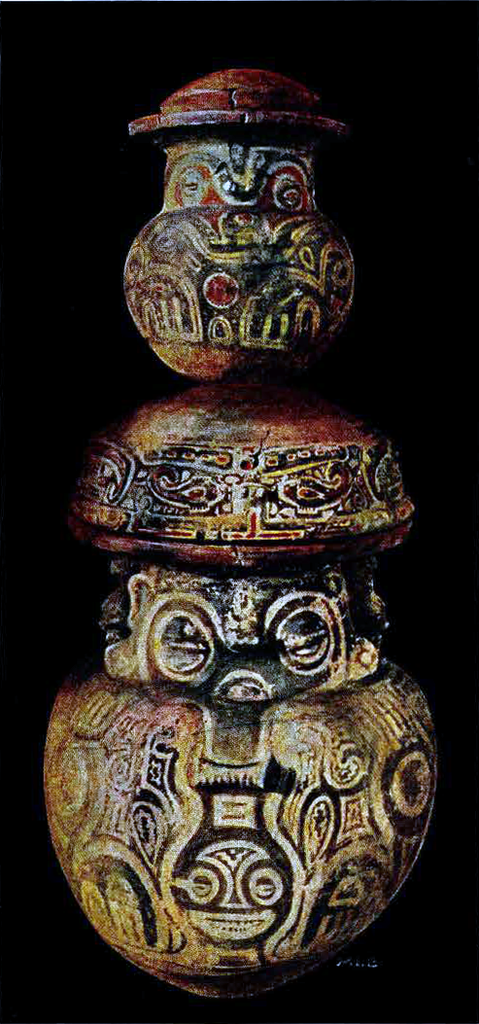
The island is nearly half the size of the State of Pennsylvania and is divided into two almost equal parts of forest and savannah. The eastern half, a remnant of the original land mass, is a grass covered plain, while the western or upstream side, partially of alluvial deposit, is covered with a rank forest growth, the home of the rubber tree.
The open plains today constitute a great grazing ground where cattle abound, some of the fazendas or ranches having as many as fifty thousand head. The cattle suffer from two extremes of drought and excess of moisture. Every year many are drowned in the lowlands, others stand for three or four months knee deep in water, as they never lie down in water more than a foot deep. Many calves are killed by alligators. Once in six or seven years, the dry season is prolonged and the cattle die of starvation and thirst. In 1915, more than five thousand died on one ranch alone. In such times as these, the rivers and lakes dry up and the weakened cattle attempting to wade through the mud of the banks, stick fast and are eaten alive by alligators. Having once witnessed such a performance, I never afterwards hesitated to shoot all the alligators encountered.
As the lakes contract during the dry season the alligators are forced into narrow quarters where hundreds of them may be seen in a pool a quarter of a mile long and a few yards wide. The vaqueiros, or cowboys, have great sport killing them. The boys work in trios for the sake of safety. They walk into the lake, get behind a big alligator and chase him toward the shore; one boy throws his lasso over its head and as it turns to catch him with its great mouth wide open, another lasso is thrown over from the other side and the alligator is checked up and driven to the edge of the water where the third boy strikes it across the back of the neck with his machette and severs its spinal cord. If, however, the second boy with his lasso should fail and the first becomes endangered the third catches the alligator in the side of its jaw with the end of a long pike pole and holds it until the second lasso is secure. It is very exciting sport and fraught with sufficient danger to satisfy even the wildest vaqueiro. Occasionally a man is caught but help is always at hand.
One Saturday afternoon in December, 1915, I saw more than two hundred alligators killed by this method on the fazenda of Dr. Miranda, and I afterwards learned that some three hundred were killed. at the same lake the next Saturday.
In former times horses thrived so well on the island that they took possession of the grazing grounds to such an extent that about 1840 the ranchers killed them by thousands for their hides. At present a strange disease is attacking the horses, and it is with difficulty that the ranchers can keep enough to use in herding cattle. In fact, during the rainy season, the ox has turned the table on the horse to such an extent that I have witnessed cowboys mounted on oxen herding horses.
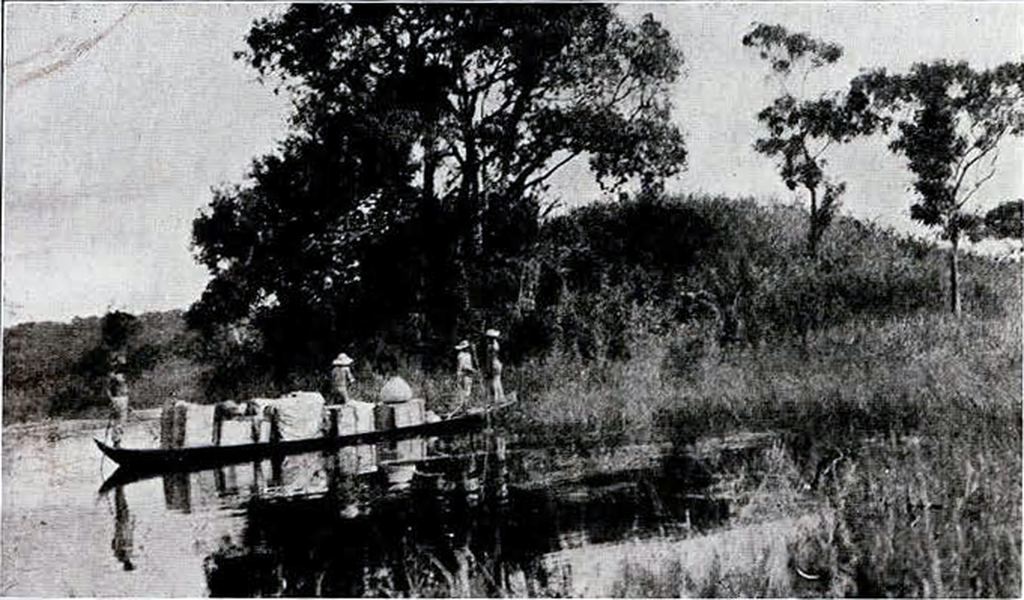
Image Number: 18174
In the very center of the island is a shallow lake called Arary, fifteen miles long and three miles wide, having as an outlet to the Amazon a river by the same name, which is navigable for sailboats and gasoline launches. On the east side, small streams flow into the sea, the tides bring salt water far up into the land, so that the cattle are compelled to drink brackish water except during the rainy season. Not far from the lake rises the Anajas River, which flows to the west and on the way receives the Comotins and Moçoes. On the margins of the lake and along the banks of these rivers are numerous artificial mounds of earth built up to a height, in extreme cases, of fifteen or twenty feet and covering an area of two or three acres. The first of the mounds to attract attention and to reveal its artificial origin was one on the island of Pacoval in Lake Arary. The action of the waves destroyed one side of the mound, exposing fragments of pottery and stratified ashes, thus proving that it had been erected by man.
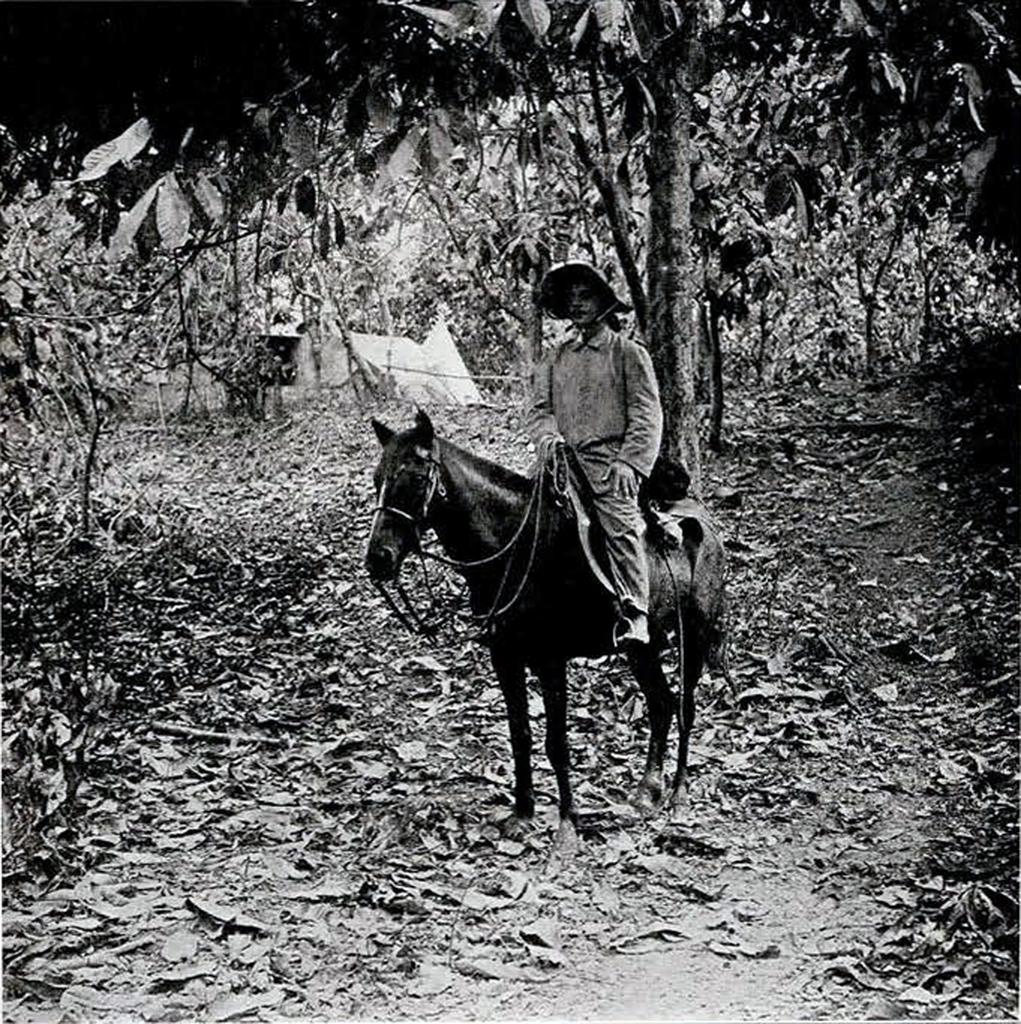
Image Number: 18123
All the mounds are oval or elliptical in shape, never in geometric or animal forms. They often have broad, flat top’s and are constantly used as sites for houses, corrals, and orchards. In this way so many of them have been destroyed that few are left worth investigating. Many have been destroyed by men digging for large burial urns which they use for the storage of water or farinha. The smaller pots are thrown aside along with the large ones they break during the excavations. I found a perfect one three feet high set at the corner of a house to catch rainwater; the falling of the rain and the rubbing of the cattle had completely obliterated the paint and designs on the pot.
Owners of the land, for some unexplained reason, are very loath to have the mounds excavated. I had great difficulty in getting permission. Dr. Vincente Miranda, owner of a large ranch, said that he did not know of any mounds on his land, but I was at liberty to excavate if I could find any. We located several of medium size and excavated four without finding a solitary thing of value. They had been used as house sites only, as was indicated by the presence of ashes and fragments of pottery.
While we found no burials or anything else of value from an archaeological standpoint, we made a most interesting and valuable discovery in connection with the changes of level at the mouth of the Amazon. Some geologists asserted that the island was slowly rising, as was indicated by the steep bluffs along the sea. The “oldest inhabitants” are quite certain that the island has been slowly sinking within recent years, because, they say, there is very much less high land in the interior than there was in the earlier days.

Museum Object Number: SA1575
Image Number: 20875
Trees of large size are often found growing on and about the mounds. The mark of the high water is clearly indicated on their trunks. The upper line of horizontally stratified ashes in the mounds shows the height of the highest floods during the time when the mounds were being built up. We have here, then, the markings on the trees and the markings in the mounds for a comparison. We found upon a careful examination that the lines on the trees practically coincide with the highest lines in the mounds, proving that the island has not noticeably changed level since these mounds were erected by the ancient people in prehistoric times.
After two weeks of fruitless digging with fourteen men, we were finally rewarded by finding a mound at Forteleza about ten feet high, covering more than an acre of ground, which had been built up artificially and then used as a village site (Fig. 40). Apparently the people had cremated the remains of their dead and buried the ashes in small urns in the floor of their houses. These urns were beautifully decorated with incised lines or paint or both (Fig. 41). Many plates, small bowls, cooking pots, and seats were found buried with these urns.
About twenty miles west of this group Mrs. Magno gave permission to excavate a mound twenty feet high, three hundred feet long, and seventy-five feet wide, located on the bank of the Cornotins River. This great mound had been built up artificially to near its present height and had been occupied by a village whose people deposited their refuse just outside of their doors and buried their dead in the mound in great urns three feet high, in which the bodies had been placed in a sitting posture. These urns are beautifully decorated with incised designs in geometric and human forms. It would appear that a part of the dead were cremated and the ashes buried in small urns of beautiful form and design. Later, other people occupied the mound, who also buried their dead seated in great urns of beautiful form and design but of entirely different manufacture from those of the earlier people. They, too, cremated a part of their dead and buried the ashes in small urns of similar form and design to the large ones. These large urns were apparently not manufactured primarily for burial purposes but, no doubt, were first used for the storage of water. This we infer from the fact that we often found the body of an urn, with an incomplete or broken neck, used for burial.
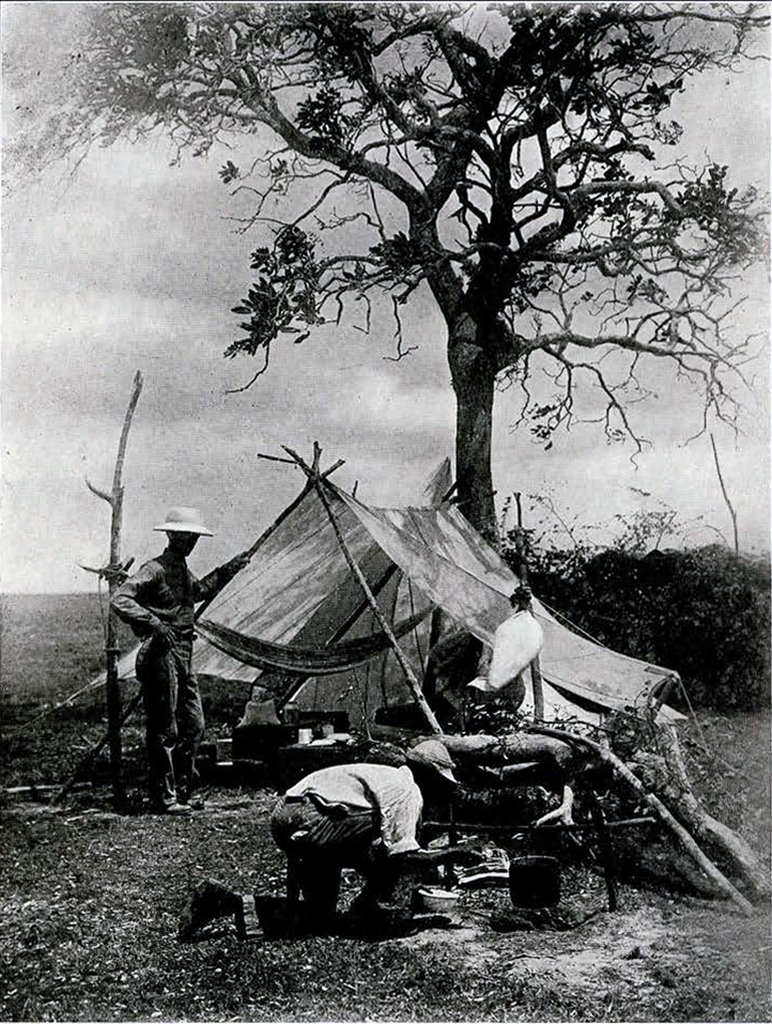
Image Number: 18115
Plate V shows one of two double burials found in which both cremation and inhumation were represented. The mouths of the urns were always covered either with a beautifully painted shallow bowl as shown in this photograph, or with a great flat plate inverted over the mouth and often extending to the edge of the lip. The lips were sometimes so broad and flat that it was necessary to support them with caryatid figures in low relief, standing on the shoulders of the urn and resting against its neck. These figures were balanced, two on each side, or four equidistant around the neck.
Whatever ornaments were originally worn and buried with the dead had entirely disappeared. Nothing whatever was found on the inside of the burial urns except the so-called “tangas” or fig leaves supposed to have been worn by the women. Many fragments of these tangas turned up in the general digging, but only perfect ones were found inside of the urns, where they always occurred at the very bottom. The tangas were always well made, hard burned, highly polished, and either in bright red monochrome or painted designs. No two have been found alike. The slight difference in form and in the flare of the corners and in the designs would seem to indicate that they had been made to order and to fit the wearer.
When the urn was placed in the grave, the bottom of the hole was dug to fit it, so that all of the smaller pieces of pottery placed with the dead were deposited at the side of the neck on the shoulder of the urn. In the general digging, the most important of the smaller objects recovered resembled in size and form the ancient Roman lamps, having an open bowl and a short stem with a hole for the wick. They may have been lamps, or, as a medical doctor suggested, they may have been used as medicinal cups for the sick; each observer is entitled to his guess.
One of the first questions asked in reference to these remains is as to their age. Unfortunately, there is no possible criterion for fixing the exact age of any archaeological remains in the New World. If articles of European manufacture are discovered in the remains, then the age is clearly fixed as Post-Columbian. On the other hand, if no evidence of European contact is revealed, we can only say that the finds are prehistoric, which may mean five hundred or a thousand years before the discovery. For the culture of the island of Marajo, there is nothing available for fixing even a relative age. No European articles were found in any of the mounds excavated; so we are justified in claiming for them an age of more than four hundred years, the time which has elapsed since the discovery of the Amazon.
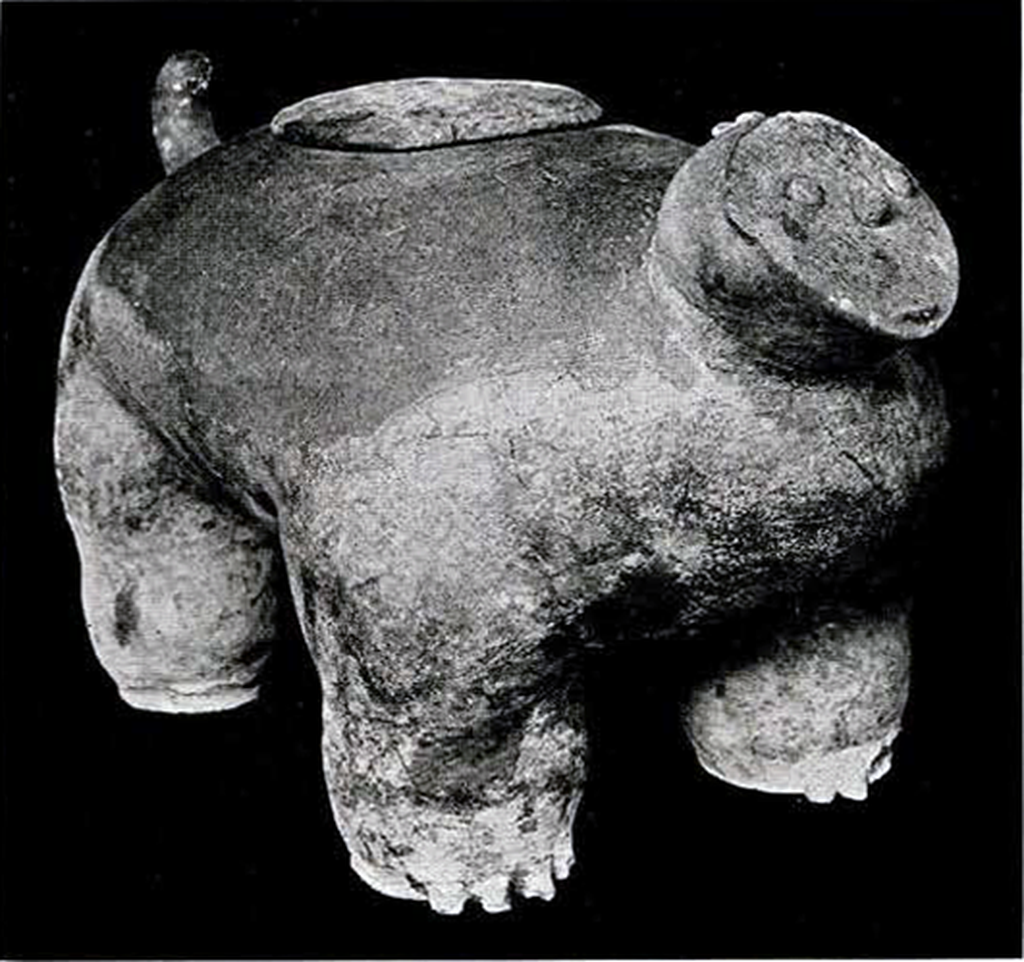
There are other evidences also which would allow them a considerable or even a great age. Although the bodies had been placed in covered urns and buried in the mounds high above the flood plain, the skeletons had entirely disintegrated—even the enamel of the teeth had disappeared. In the refuse heaps where bones of animals are cast away with other kitchen remnants, no evidence of bones or shells was found. This would appear to argue for a rather great age. I have explored prehistoric mounds in the Mississippi delta where the conditions of soil and rainfall are very much the same as they are here on the Amazon. In the Mississippi I found human bones well preserved where they had been buried without protection, in direct contact with the earth. Animal bones were also found, well preserved and in very great abundance. It is true, however, that there is a greater rainfall at the mouth of the Amazon and, besides, we know nothing about the chemical composition of the soil, which might affect the preservation of the bones.
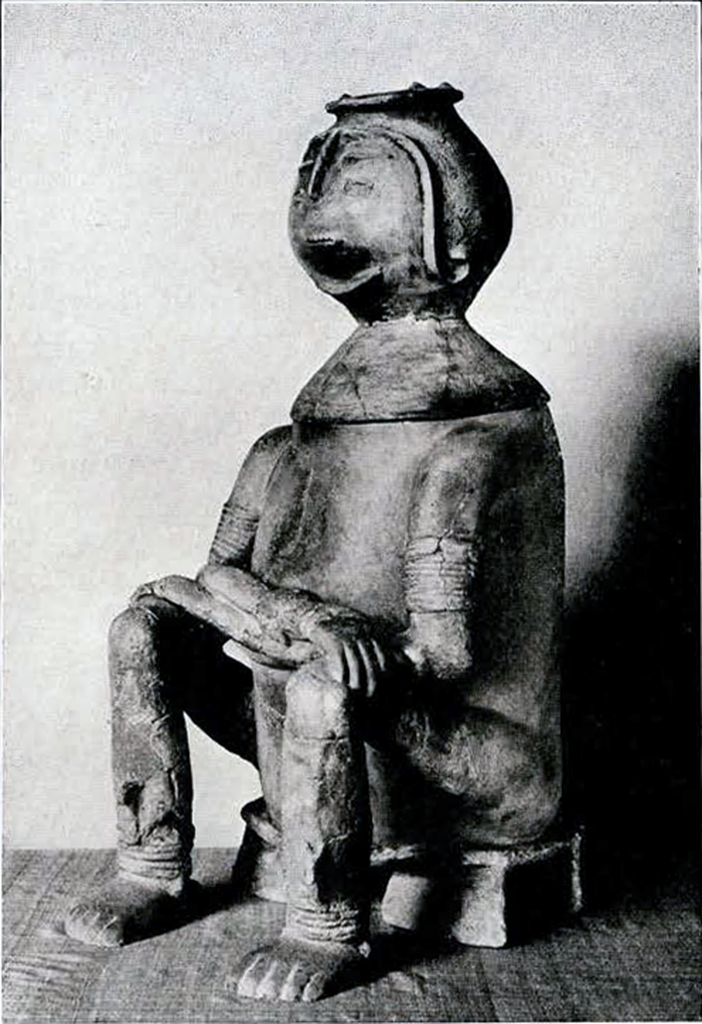
One can easily understand why so few articles were found with the burials in the mounds of Marajo. There is no stone in the Amazon valley suitable for the manufacture of implements; hence, the very few found must have come from a long distance. Because of this lack of stone, the implements must have been made of wood, bone, and shell. All of these have entirely disappeared and left nothing but pottery behind.
I have said the bodies had been buried intact in a sitting position inside of these great urns, and now I must explain how we were able to determine that fact. Many of the urns were broken from the weight of the superposed earth, and when excavating it was convenient to remove these fragments before disturbing the earth in the interior. This method allowed us to cut down in cross sections and expose the outline of the bodies in profile. As the bones decomposed, silted earth took their places; so, by carefully cutting away the earth, we were able to trace out all the bones of the body. In many cases, in the early stages of decomposition, the head had fallen forward from the trunk and remained face up on the bottom of the urn. The body, no doubt, had been wrapped in cloth or bark and then deposited in the urn after it had been placed in a hole dug in the mound. The neck of the urn was sufficiently large to admit the body in this form. In one of the largest of the urns two adult bodies had been seated side by side.
Many times the grave digger encountered an earlier burial, but instead of selecting another site, he continued and broke away the upper part of the urn and seated his own on the top of the earlier burial.
So far, we have been unable to find conclusive evidence that the people were clothed or manufactured cloth of any kind. In the North American mounds, cloth marked pottery was often found, but here nothing of the kind has been discovered. In all our excavating, only one spindlewhorl, or object that might have been used for that purpose, was discovered. If the people were acquainted with spinning, it is rather strange that more spindlewhorls or other evidence has not been found. The people may have dressed as some of the modern natives do today, in bark cloth, but even this is doubtful. If the socalled tangas were used as fig leaves it is highly improbable that any clothing was worn over them, as they are always well made, beautifully decorated and worn to be admired. If the women wore tangas, the men must also have worn some protection, which was more than likely made of bark.
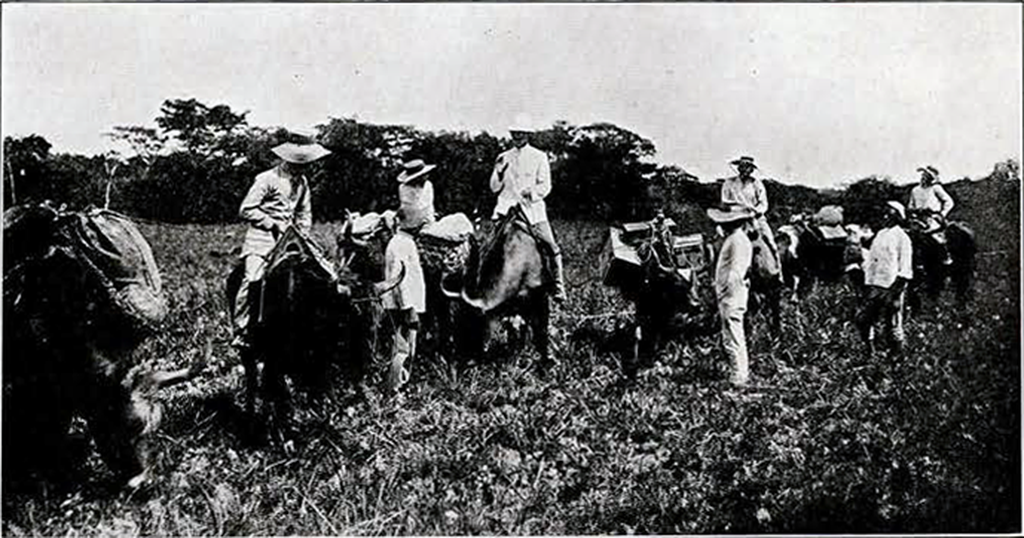
Image Number: 18159
From all the indications and the information at present obtainable, it would appear that the high state of culture here represented is indigenous to this one island. It is not directly related to any other known culture; but it is true that little archeological work has been done along the coast of Brazil north and south of Marajo, and evidence may yet be found of some contact. The art represented is so free and bold, as represented in Plate V, that it would seem to have sprung into being readymade. There is no evidence in the material found of a development from a lower culture; but, again, this may be due to the fact that little systematic work has been done in the island.
Life on the island of Marajo during the dry season is very delightful. There are no mosquitoes nor troublesome insects and the constant trade winds produce continued evaporation, so that one never feels or appreciates the continued heat. By observing the photograph in Fig. 42, it will be noticed that to prevent our camp from blowing away, it was necessary to anchor it to a tree; and it will also be noticed that my boy cook was compelled to dig a deep hole to preserve his fire. This observation may be of service to campers who have had difficulty in building and keeping a fire in the wind.
We were encamped about a hundred yards from a small stream. At daybreak when I went for my bath, I took along with me my Remington repeating shotgun and every morning, without exception, before I had finished my bath, I had brought down from one to six ducks as they were flying up the stream. Thus, without hunting, I provided all the meat we used in camp. I should make one reservation, however. We practically lived on rice and duck, but ants by the millions got into the rice. My boy, accustomed to ants, did not think it necessary to remove them, and cooked ants, rice, and duck together. In the process of cooking, the ants would rise to the surface with the oil of the duck. One day, when ants seemed more plentiful than common, I suggested to the boy his Portuguese proverb that eating ants was good for the eyesight and that if he were to take his share of the meal from the top, he might be able to observe the ants next time. With a broad grin, he played the sport and ate the ants; and it had the desired effect. But do not waste sympathy on the boy, he got only a few more than I did or than we were accustomed to have every day. My only objection to them is their acid taste—they are too sour and should be eaten with sugar, but you can’t put sugar on duck.
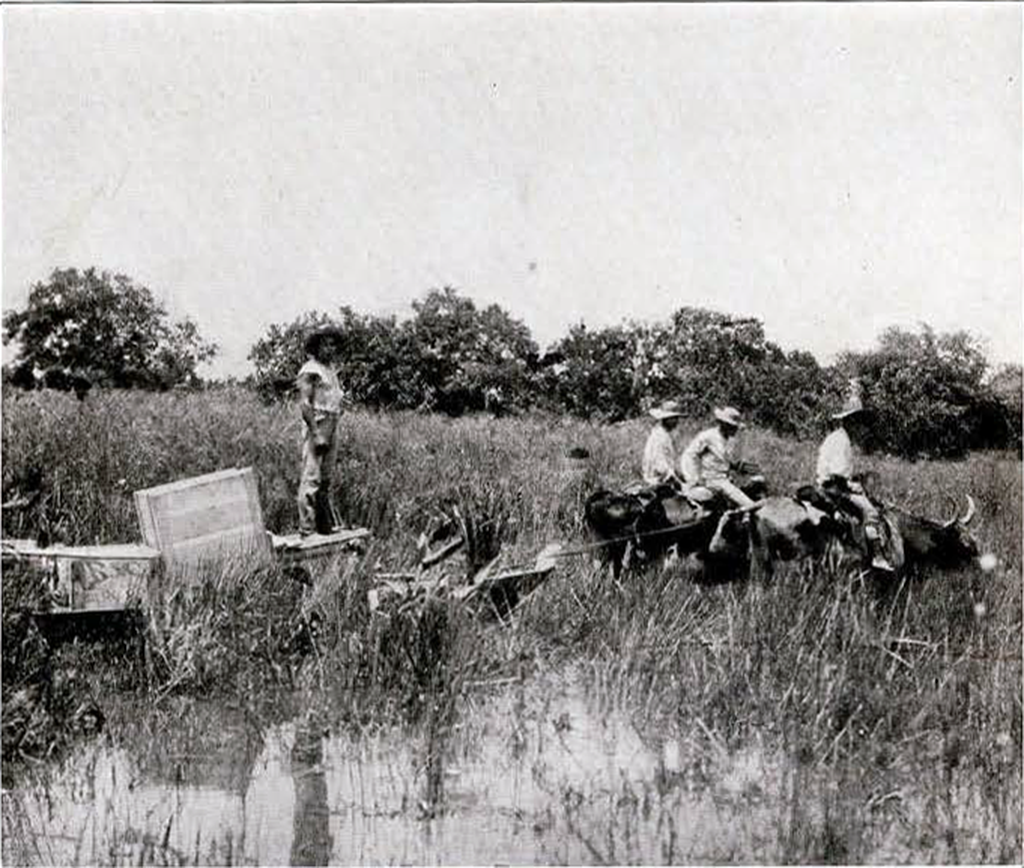
Image Number: 18153
We had many visitors at our camp—cowboys, ranch owners, hunters, and troops of mendicants. A friend from the city tried to induce me to spend a day with him hunting deer, but I was too busy and he went with a cowboy, returning at four o’clock with ten deer. There are few opportunities for the cowboys on the great fazendas to attend religious services; so groups of a half dozen men travel about from fazenda to fazenda celebrating mass. The mass was all right but the music was the most horrible I have ever heard. As I kept no money in camp for contributions, all I could do was to soften the singers’ voices with some good wine I kept on hand for distinguished visitors.
My own work in the excavations was more laborious than it otherwise would have been, because all my workmen were inexperienced and it was necessary for me to remove all the objects from the earth with my own hands. This fact, however, may be responsible for the observations that some archaeologists have made upon looking over the collection, that is, that there are few marks of implements upon the specimens. Although we were working in the open, under a direct sun, in the dry season, and I never worked harder in my life at physical labor, I was in perfect health during the whole time.
The next three months, spent in our sailboat exploring the islands and excavating, was the most disagreeable of my experiences. Our excavations were in the depths of the forest where there was no breeze blowing. Rain fell every day; our clothes and shoes were covered with mold at night; rain filled our excavation trenches and interfered with our digging. We were soaked from outside in and from inside out and covered with mud from head to foot. Ants with various kinds of stings and bites and different dilutions of formic acid; ticks, jiggers, red bugs, and brown bugs were plentiful; but most troublesome of all, day time and night, were the mosquitoes. At night we could escape them in our nets. During the day I worked with a head net and gloves and hired a boy with a brush to keep the mosquitoes off my back; but he preferred, instead of keeping them off, to allow them to bite and then kill them to see the blood splash. But there was plenty of water for washing clothes and for bathing, and one forgets these little discomforts when he sees the unique results of his labors.
When our excavations were completed, at the end of the dry season, it was necessary for us to build a house to protect our collections until the middle of the rainy season—some four months later—when it would be possible to reach the place by canoe. There are no roads on the island, consequently, everything from the interior must be packed on oxback to the nearest navigable place on the river, where it is carried by canoe to a stopping station of one of the Para steamers. As it was impossible to carry such large packing cases as used for our burial urns, we were compelled to delay the transportation until the wet season.
In the meantime, we explored a number of islands along the river above Marajo and on the mainland north of the river.
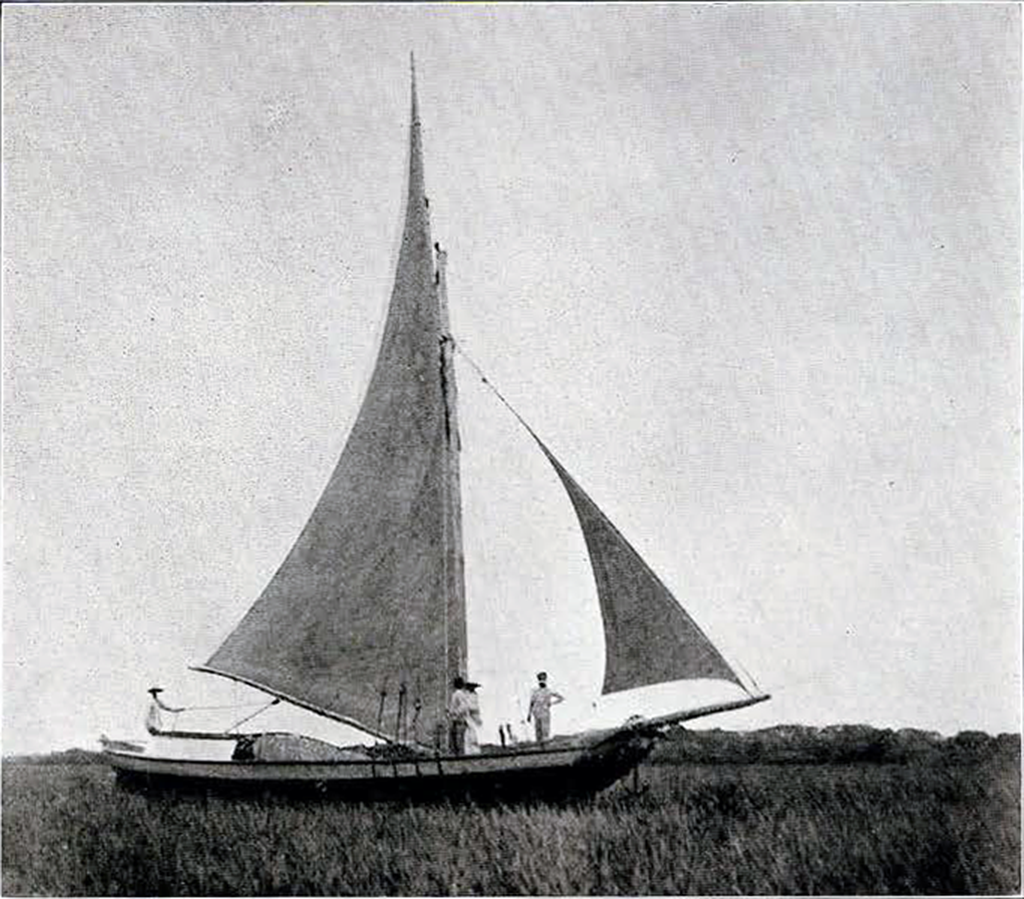
Image Number: 18144
On the Ilha dos Puercos, Island of the Pigs, there are numerous village sites; but, apparently, the people removed their dead to a small island nearby called Ilha do Para. On this small island we were unable to find evidence of occupation or village sites, but near the center of the island the land rises to about three feet above the level of high waters; and here we found the ground literally covered with burial urns of peculiar form, Fig. 43. These burial jars had been placed side by side on the surface of the ground in groups of from two to a dozen, without any protection or covering whatever. The falling limbs of trees and growing roots had disturbed and broken nearly all of them, yet it was possible to obtain the fragments because they had not been scattered.
The urns were made in the form of four footed beasts having large flat bodies, short tails, big legs, and flat feet with four or five toes. The head was in the form of some animal or man. The body of the pot was never more than two feet long. The hole in the top for the reception of the human bones was covered with a flat plate apparently made for the purpose. The bones must have been disarticulated before they were placed in the urn. No implements of any kind were found inside the urns or about these peculiar burial places. The bones were partially preserved.
On the mainland, some two hundred miles north of the Amazon, burial urns in the form of a seated man were found in a cave (Fig. 44). The head, with the face very well modeled, served as a cover. In the region round about, many village sites were excavated and interesting fragments of pottery were found. These urns in the form of a man were too small for the burial of bones. Apparently, they were used as receptacles for the cremated remains.
These burials appear to belong to a much later period, because in some of the urns of animal form, as described above, and found on the mainland and those of human form, well preserved shell beads were found; and in one, the largest of those of human form, were found a few large glass beads of European manufacture. The fact that these glass beads were found in but one of the great number of burials and that in the most important one, would seem to indicate that these remains belong to the very first contact with Europeans.
One other important group of remains was investigated near Santarem, a small town on the Amazon, at the mouth of the Tapajos River, some four hundred miles from the sea. One of the natives had a few fragments of pottery which he said came from the “black earth” on the top of the mountains, about ten miles back from the river. Upon investigation, this black earth, as I had supposed, marked the site of an ancient Indian village. The location was on the edge of a high plateau overlooking the Amazon. A number of such sites were located by one of two methods; either by finding the black earth, or by first locating a spring and then, looking for the village site on the plateau top nearby. The black earth marking these sites was found to be from one to two feet deep and covered in some cases, as much as ten acres of surface. No burials were found and nothing but broken pieces of pottery. The culture represented here, judging from the fragments of pottery, is entirely distinct from that of Marajo.
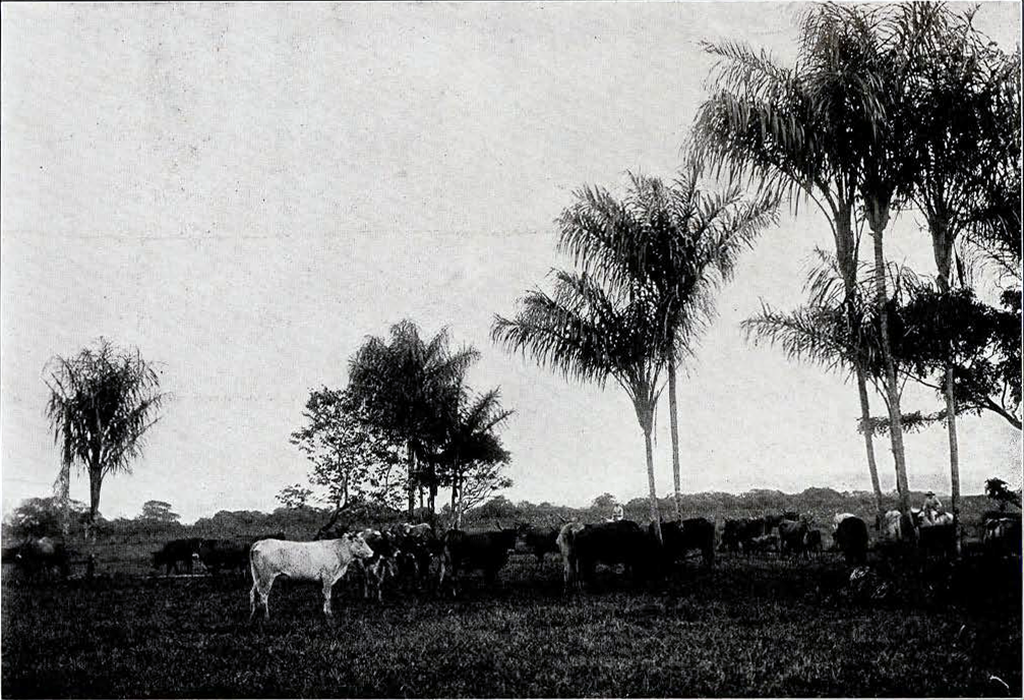
Image Number: 18169
While investigating the archaeological remains near Santarem, we made another interesting discovery. The man who owns the great body of land on which these ancient remains were found, is an American; one of the four remaining representatives of a colony formed at Santarem at the close of our Civil War. The men are well-to-do and are a good example of what energetic whites can accomplish even in the tropics. They all have Brazilian wives and numerous Portuguese-speaking children. When Brazil became a republic in 1878 and all foreigners were required to make declarations of their intentions, all of this colony, with one exception, decided to retain their American citizenship. Two of these men have never been back to the United States, but they still are proud to retain their citizenship and promise themselves from year to year a final visit to the old home. Naturally, Mrs. Farabee and I were well received by these men and their families and it is a pleasure to acknowledge our great indebtedness to them.
By the middle of May there was sufficient water to float a canoe all over the interior of the island of Marajo. We hired a sailboat with an eighty foot mast, loaded her with empty packing cases of various sizes, many of them three feet square, to accommodate the large burial urns; and went to see what had happened to our collections, to pack and to ship them to New York.
The house we had built we found intact and the collections undisturbed; but a great snake had taken possession under the floor and scorpions had mingled themselves with broadwinged roaches and occupied the dry spaces among the pots, making packing somewhat dangerous. It was not safe to put one’s hand inside of a jar without first exploring it with a club.
When we excavated at Forteleza, I was able to obtain boxes and pack the collection before leaving our camp. It was now only necessary to load the boxes in a canoe and sail away with our oxen. We were quite surprised, however, when we attempted to remove the first large box. It was standing on top of the others in apparent perfect condition, but as soon as we attempted to move it, it fell to pieces and the contents scattered on the ground. During our absence, the termites had eaten away the interior of the wood, thus allowing the box to collapse. They had also eaten all of the labels and notes packed with the collections; so it was necessary to return with other boxes and repack the whole collection.
Form Para to the island of Marajo, fifteen miles across the bay, we traveled in a large sailing boat which tossed about frightfully on the rough sea. The natives are expert in taking advantage of current, tide and wind. Para is located seventy-five miles up the river from the sea. We would drift down with the tide at night and in the morning, return with the returning tide and by means of the constant winds, tack across the bay to the mouth of the Arary River. The eastern side of the island is a great plain, the trade winds are unobstructed, hence it is possible to sail up the small rivers to the very center of the island. On account of the short turns in the narrow rivers, great care is required in tacking around the corners. It is not an uncommon thing to run aground, when all hands turn to with poles to push the boat off.
During the wet season, the grass grows rapidly and covers the water so that one often finds himself sailing through a great meadow with no water in sight in any direction, although it is six or eight feet deep under his boat. Although our boat was of shallow draught, we were unable to cross the low divide between the Arary and the Comotins where our collections were stored and we had to secure oxen to haul our canoe back and forth from the camp to the boat. One naturally asks why we did not paddle our canoe. The answer to this question at the same time answers the other more perplexing one of why the oxen are hitched by their tails. As the grass grows in the warm weather, it mats together so closely that it is next to impossible to push a canoe through it and it becomes necessary to haul it with an ox; but why not use two oxen and a yoke?
The ox is broken to ride because he is much safer than a horse in swampy lands. His feet spread out as they go down in the bog and fold up as they are pulled out. Therefore, he never sticks fast and falls down. He is ungainly and impossible on the gallop but is usually a better walker than a horse. He is badly affected by the direct heat of the sun, so we often rode across the savannahs in the moonlight. He has a remarkable ability in following the way with which he was acquainted during the dry season but which now is covered with three or four feet of water. He zigzags about as he goes along unguided by the rider and always emerges at the desired place. If one attempts to ride with a tight rein, stiff legs, and straight back, he is soon worn out; but if he rides as loosely as a stuffed dummy and surrenders himself to his animal, he soon enjoys it.
The ox’s head is so low that the rider feels in danger of toppling over—there is no mane to clutch. One other sensation I was never able to completely overcome. When the ox steps into a soft bog with one front foot, his shoulders are so loosely joined that he appears to cast the leg adrift and go on without it. The explanation is that the rider misses the violent muscular efforts he has been accustomed to feel when riding a horse. The yoke is not used because the boy wants to ride and because a single ox breaks a path in the long grass through which the canoe is pulled with little effort. Besides it is so easy to tie the tail and a lot of trouble to use a yoke.
We left our sailboat standing in the deep grass, loaded our large canoe with empty packing cases, threw a clove hitch over the tails of our oxen and crossed the divide to our old camp on the Comotins, a long day’s journey away. I remained behind alone to pack while the boys returned to the boat for another load of boxes. And so on; a trip a day, loaded one way and empty the other, until all the collection was packed, transported, and stored aboard our sailing boat.
On my way out I called to settle for the services of the men and the oxen. The owner of the fazenda said, “You have had four men ten days, have used twenty-two oxen and pulled out six tails, your bill is twenty-seven dollars and a half.” By pulling out the tails, the owner meant that the oxen by some sudden jerk had dislocated some of the bones of the tail. They would recover in six months.
Everything on the island is hauled in this fashion—firewood, fences, canoes and even all the timbers for houses. An ox can pull about half as much in this way as he could with a yoke. It is a heartless lazy man’s method. After one has been hauled in this fashion for a few weeks and has pulled out a few tails, more or less, he is never known to order oxtail soup again. Don’t try it.
The expedition is indebted for assistance to the Government Officials generally; to Dr. Vincente Miranda, whose home on Marajo was our rendezvous, for permission to excavate at Forteleza; to Bertino Miranda for laborers in the field; to Mrs. Elvira Magna y Silva for permission to excavate at Comotins; to the scientific staff of the Goeldi Museum for advice and helpful cooperation and to the American Consul, Hon. George H. Pickerell, whose office was our headquarters for three years.
W. C. F.

